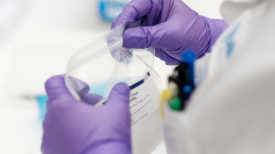- Cancer Care Team
Cancer Care Team
To deliver optimal patient outcomesProducts and Services
Cancer Type
Supplies & Tools
Scientific Focus
- Biopharma Partners
- Patients
- Education & Events
- Login
- Contact Us
Test Details
 Technology Used
Technology Used
FISH
Use
This test is used for classification of certain tumors. MDM2 amplifications are frequently detected in well-differentiated liposarcoma (WDL), which includes atypical lipomatous tumor (ALT) and in dedifferentiated liposarcoma (DDL)
This test is used for classification of certain tumors. MDM2 amplifications are frequently detected in well-differentiated liposarcoma (WDL), which includes atypical lipomatous tumor (ALT) and in dedifferentiated liposarcoma (DDL) This test is used for classification of certain tumors. MDM2 amplifications are frequently detected in well-differentiated liposarcoma (WDL), which includes atypical lipomatous tumor (ALT) and in dedifferentiated liposarcoma (DDL) |
This test is used for classification of certain tumors. MDM2 amplifications are frequently detected in well-differentiated liposarcoma (WDL), which includes atypical lipomatous tumor (ALT) and in dedifferentiated liposarcoma (DDL) This test is used for classification of certain tumors. MDM2 amplifications are frequently detected in well-differentiated liposarcoma (WDL), which includes atypical lipomatous tumor (ALT) and in dedifferentiated liposarcoma (DDL) |
Special Instructions
Pertinent clinical diagnostic information, including the pathology report documenting tumor origin and grade, should be included with the specimen. Additional charges will be applied for the embedding process if formalin-fixed tissue is submitted.
Pertinent clinical diagnostic information, including the pathology report documenting tumor origin and grade, should be included with the specimen. Additional charges will be applied for the embedding process if formalin-fixed tissue is submitted. Pertinent clinical diagnostic information, including the pathology report documenting tumor origin and grade, should be included with the specimen. Additional charges will be applied for the embedding process if formalin-fixed tissue is submitted. |
Pertinent clinical diagnostic information, including the pathology report documenting tumor origin and grade, should be included with the specimen. Additional charges will be applied for the embedding process if formalin-fixed tissue is submitted. Pertinent clinical diagnostic information, including the pathology report documenting tumor origin and grade, should be included with the specimen. Additional charges will be applied for the embedding process if formalin-fixed tissue is submitted. |
Limitations
Use of fixatives other than 10% formalin or fixation times less than six hours or more than 72 hours may not yield reliable results. Suboptimal pre-analytic variables, including cold ischemia time outside the recommended guidelines, extended duration of fixation, fixation other than paraformaldehyde and tissue decalcification, may negatively impact results. Results of the MDM2 FISH assay should always be used in conjunction with other information available from the clinical evaluation of the patient and other prognostic factors, such as tumor size, histologic grade, and other known risk factors.
This test was developed and its performance characteristics determined by Labcorp. It has not been cleared or approved by the Food and Drug Administration.
Use of fixatives other than 10% formalin or fixation times less than six hours or more than 72 hours may not yield reliable results. Suboptimal pre-analytic variables, including cold ischemia time outside the recommended guidelines, extended duration of fixation, fixation other than paraformaldehyde and tissue decalcification, may negatively impact results. Results of the MDM2 FISH assay should always be used in conjunction with other information available from the clinical evaluation of the patient and other prognostic factors, such as tumor size, histologic grade, and other known risk factors. This test was developed and its performance characteristics determined by Labcorp. It has not been cleared or approved by the Food and Drug Administration. Use of fixatives other than 10% formalin or fixation times less than six hours or more than 72 hours may not yield reliable results. Suboptimal pre-analytic variables, including cold ischemia time outside the recommended guidelines, extended duration of fixation, fixation other than paraformaldehyde and tissue decalcification, may negatively impact results. Results of the MDM2 FISH assay should always be used in conjunction with other information available from the clinical evaluation of the patient and other prognostic factors, such as tumor size, histologic grade, and other known risk factors. This test was developed and its performance characteristics determined by Labcorp. It has not been cleared or approved by the Food and Drug Administration. |
Use of fixatives other than 10% formalin or fixation times less than six hours or more than 72 hours may not yield reliable results. Suboptimal pre-analytic variables, including cold ischemia time outside the recommended guidelines, extended duration of fixation, fixation other than paraformaldehyde and tissue decalcification, may negatively impact results. Results of the MDM2 FISH assay should always be used in conjunction with other information available from the clinical evaluation of the patient and other prognostic factors, such as tumor size, histologic grade, and other known risk factors. This test was developed and its performance characteristics determined by Labcorp. It has not been cleared or approved by the Food and Drug Administration. Use of fixatives other than 10% formalin or fixation times less than six hours or more than 72 hours may not yield reliable results. Suboptimal pre-analytic variables, including cold ischemia time outside the recommended guidelines, extended duration of fixation, fixation other than paraformaldehyde and tissue decalcification, may negatively impact results. Results of the MDM2 FISH assay should always be used in conjunction with other information available from the clinical evaluation of the patient and other prognostic factors, such as tumor size, histologic grade, and other known risk factors. This test was developed and its performance characteristics determined by Labcorp. It has not been cleared or approved by the Food and Drug Administration. |
Methodology
Fluorescence in situ hybridization (FISH)
Fluorescence in situ hybridization (FISH) Fluorescence in situ hybridization (FISH) |
Fluorescence in situ hybridization (FISH) Fluorescence in situ hybridization (FISH) |
Specimen Requirements
Information on collection, storage, and volume
Specimen
Adipocytic tumors; formalin-fixed paraffin-embedded (FFPE) tissue
Adipocytic tumors; formalin-fixed paraffin-embedded (FFPE) tissue Adipocytic tumors; formalin-fixed paraffin-embedded (FFPE) tissue |
Adipocytic tumors; formalin-fixed paraffin-embedded (FFPE) tissue Adipocytic tumors; formalin-fixed paraffin-embedded (FFPE) tissue |
Volume
Four slides (4 micron) on positively charged slides or one paraffin block
Four slides (4 micron) on positively charged slides or one paraffin block Four slides (4 micron) on positively charged slides or one paraffin block |
Four slides (4 micron) on positively charged slides or one paraffin block Four slides (4 micron) on positively charged slides or one paraffin block |
Minimum Volume
Two slides (4 micron) on positively charged slides or one paraffin block
Container
Paraffin block
Paraffin block Paraffin block |
Paraffin block Paraffin block |
Storage Instructions
Maintain specimen at room temperature
Causes for Rejection
Use of fixatives other than 10% formalin; improper embedded preparation; poor fixation less than six hours and greater than 72 hours; decalcified bone or bone core; absence or quantity or tumor insufficient for analysis
Collection
Time from tissue acquisition to fixation should be as short as possible; samples for MDM2 testing should be fixed in 10% neutral buffered formalin for six to 72 hours.




